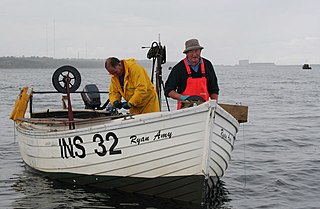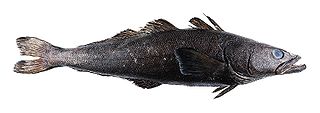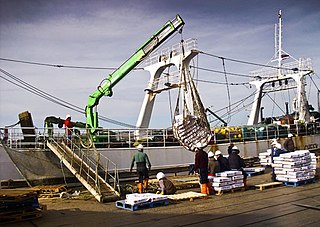| History | |
|---|---|
| Port of registry | |
| Fate | Scrapped December 2007 |
| General characteristics | |
| Type | fishing vessel |
Viarsa 1 was a Uruguayan-flagged fishing vessel famous for its involvement in a high seas chase.
| History | |
|---|---|
| Port of registry | |
| Fate | Scrapped December 2007 |
| General characteristics | |
| Type | fishing vessel |
Viarsa 1 was a Uruguayan-flagged fishing vessel famous for its involvement in a high seas chase.
On 7 August 2003, Australian Customs and Fisheries patrol vessel Southern Supporter spotted Viarsa 1 in Australian territorial waters near Heard Island. Suspecting the vessel of illegal fishing for toothfish, the Australians ordered the crew to stop. They fled, and this began a chase that would last for three weeks. The pair of vessels faced huge seas and numerous icebergs, and the rivalry was briefly suspended when the fishermen became lost in Antarctic sea ice and were directed to safety by the Australian sailors.
As the chase progressed across thousands of nautical miles of ocean, Southern Supporter was joined by the South African salvage tug John Ross and polar icebreaker SAS Agulhas and Falkland Islands-based British fisheries patrol boat Dorada. On 28 August, after 3,900 nautical miles (7,200 km), the contingent, led by Australian Customs Officer Steve Duffy, surrounded Viarsa 12,000 nautical miles (2,000 mi; 4,000 km) south-west of Cape Town, South Africa.
Meanwhile, a steaming party of Australian personnel flew to South Africa and boarded the oiler SAS Drakensberg, which met the other ships on 3 September. Southern Supporter and Viarsa 1 arrived in Fremantle, Western Australia, on 3 October. Viarsa 1 captain Ricardo Mario Ribot Cabrera and his four shipmates posted bail and were ordered to remain close by and await legal proceedings. They found lodging at a hostel for merchant seamen.
It was the longest chase of an ocean poacher in history until the Sea Shepherd vessels Bob Barker and Sam Simon intercepted the Nigerian-flagged trawler Thunder , also a toothfish poacher, and pursued her from December 2014 to April 2015 as part of Sea Shepherd's "Operation Icefish" campaign. [1] [2]
Despite the 97 tonnes of toothfish found on board the vessel, representatives for the owners of Viarsa 1 secured an acquittal by jury in November 2005. After two trials and two years, the seamen were free to return to their home countries. [3]
According to the environmental advocacy group Oceana, Viarsa 1 was scrapped at an Indian shipyard. [4]
Specific

Longline fishing, or longlining, is a commercial fishing angling technique that uses a long main line with baited hooks attached at intervals via short branch lines called snoods or gangions. A snood is attached to the main line using a clip or swivel, with the hook at the other end. Longlines are classified mainly by where they are placed in the water column. This can be at the surface or at the bottom. Lines can also be set by means of an anchor, or left to drift. Hundreds or even thousands of baited hooks can hang from a single line. This can lead to many deaths of different marine species. Longliners – fishing vessels rigged for longlining – commonly target swordfish, tuna, halibut, sablefish and many other species.

The Antarctic toothfish, also known as the Antarctic cod, is a large, black or brown fish found in very cold (subzero) waters of the Southern Ocean near Antarctica. It is the largest fish in the Southern Ocean, feeding on shrimp and smaller fish, and preyed on by whales, orcas, and seals. It is caught for food and marketed as Chilean sea bass together with its sister species, the more northerly Patagonian toothfish. Often mistakenly called "Antarctic cod", the Antarctic toothfish belongs to the notothen family (Nototheniidae), a family of fish genera that are abundant near Antarctica.

The Patagonian toothfish, also known as Chilean sea bass, mero, and icefish, is a species of notothen found in cold waters between depths of 45 and 3,850 m in the southern Atlantic, Pacific, and Indian Oceans and Southern Ocean on seamounts and continental shelves around most Subantarctic islands.
CCGS Cape Roger is the lead ship of the Cape Roger-class fisheries patrol vessels operated by the Canadian Coast Guard. The ship entered service in 1977 and was assigned to monitor the Atlantic fisheries. During the Turbot War, Cape Roger took part in the detainment of the Spanish fishing trawler Estai. The ship is currently in service.

The Turbot War was an international fishing dispute and bloodless conflict between Canada and Spain and their respective supporters.

RV Farley Mowat was a long-range, ice class ship. Originally built as a Norwegian fisheries research and enforcement vessel, she was purchased by the Sea Shepherd Conservation Society in Edinburgh, Scotland, in August 1996. Originally named Sea Shepherd III, the name was changed in 1999 to Ocean Warrior, before eventually being renamed in 2002 after Canadian writer Farley Mowat.

CCGS Sir Wilfred Grenfell is a Canadian Coast Guard vessel based in Victoria, British Columbia. Designated an "Offshore Ice Strengthened Multi Patrol Vessel", the former offshore supply vessel is named after the medical missionary in Labrador, Sir Wilfred Grenfell. Constructed in 1984–1985, Sir Wilfred Grenfell was purchased by the Canadian Government and converted for Coast Guard service. In 1994, she played an important role in the fishing conflict known as the Turbot War in the Atlantic Ocean.

A factory ship, also known as a fish processing vessel, is a large ocean-going vessel with extensive on-board facilities for processing and freezing caught fish or whales. Modern factory ships are automated and enlarged versions of the earlier whalers, and their use for fishing has grown dramatically. Some factory ships are equipped to serve as a mother ship.

The MY Steve Irwin was the 59-metre (194 ft) flagship of the Sea Shepherd Conservation Society, and was used in their direct action campaigns against whaling and against illegal fisheries activities. The vessel was built in 1975 and formerly served as a Scottish Fisheries Protection Agency conservation enforcement patrol boat, the FPV Westra, for 28 years.

The MV Oceanic Viking was an armed patrol vessel of the Australian Customs Service. Originally built in 1996 as the offshore supply vessel Viking Lady for Norwegian shipping company Eidesvik Shipping AS, the ship was converted into a cable layer in 2000 and renamed Oceanic Viking. The ship was chartered to the Australian Customs Service through P&O Marine Services from 2004 to 2010. In 2011, it was purchased by A&P Tyne, Isle of Man, and renamed European Supporter.

Dissostichus, the toothfish, is a genus of marine ray-finned fish belonging to the family Nototheniidae, the notothens or cod icefish. These fish are found in the Southern Hemisphere. Toothfish are marketed in the United States as Chilean sea bass or less frequently as white cod. "Chilean sea bass" is a marketing name coined in 1977 by Lee Lantz, a fish wholesaler who wanted a more attractive name for selling the Patagonian toothfish to Americans. In 1994, the U.S. Food and Drug Administration (FDA) accepted "Chilean sea bass" as an "alternative market name" for Patagonian toothfish. The toothfish was remarkably successful in the United States, Europe and Asia, and earned the nickname "white gold" within the market. Toothfish are vital to the ecological structure of Southern Ocean ecosystems. For this reason, on 4 September a national day is dedicated to the toothfish in South Georgia.

The Sea Shepherd Conservation Society engages in various demonstrations, campaigns, and tactical operations at sea and elsewhere, including conventional protests and direct actions to protect marine wildlife. Sea Shepherd operations have included interdiction against commercial fishing, shark poaching and finning, seal hunting and whaling. Many of their activities have been called piracy or terrorism by their targets and by the ICRW. Sea Shepherd says that they have taken more than 4,000 volunteers on operations over a period of 30 years.

Captain Peter James Bethune is a New Zealand ship's captain with 500 ton master licence, published author, producer of The Operatives TV show, and public speaker. He is the founder of Earthrace Conservation. He works assisting countries in Asia, Central America and Africa with fisheries enforcement and anti-poaching. He is the holder of the world record for circumnavigating the globe in his powerboat Earthrace, a wavepiercing trimaran powered with biofuels.

The Overseas Patrol Squadron is a front-line squadron of the Royal Navy with responsibility for patrolling the UK's Extended Fisheries Zone, both at home and around British Overseas Territories. The squadron, with headquarters at HMNB Portsmouth, is equipped with eight of the River-class patrol vessels.

FV Margiris is the world's second largest fishing boat. It is a 9,500 GT super trawler and factory ship.

Fishing in the Falkland Islands contributes to the local economy, representing one of its biggest exports.
FV Thunder was an outlaw fishing vessel sunk in 2015. The ship was built in 1969 in Norway and has gone by many names, including: Vesturvón, Arctic Ranger, Rubin, Typhoon I, Kuko, and Wuhan N4. The Thunder was part of the "Bandit 6", a group of six fishing vessels that illegally fished for Patagonian toothfish in the Southern Ocean. The ship was last registered in Lagos, Nigeria; however, the ship was officially de-listed by Nigeria a week before she sank.
The Bandit 6 was a group of six vessels which were illegally fishing Patagonian toothfish in the Southern Ocean. Actions by the Sea Shepherd Conservation Society and national governments resulted in all six vessels being detained or sunk.

Andrey Dolgov is a former long-line fishing boat. During the 2000s and 2010s, the ship—which was engaged in a far-reaching campaign of illegal fishing—was one of Interpol's most wanted ships. The Andrey Dolgov was captured and detained by the Indonesian navy in April 2018; as of 2019 the Indonesian government intended to refurbish the ship and incorporate it into Indonesia's fisheries enforcement fleet.

The Spanish fishing trawler Sonia sank off the Cornish coast of England on 20 October 1984. On 19 October, in Irish territorial waters off the coast of County Wexford, the Sonia had been spotted by the Irish Naval Service patrol vessel Aisling and was suspected to be fishing illegally. The Sonia was ordered to halt and prepare to receive a boarding party, but did not comply.